We started the month with truly wintry conditions in place due to high pressure and a steady flow of cold air from Scandinavia. There was snow on the hills and even snow falling in the valleys at times, while hard morning frosts were followed by bright days. Nevertheless, for brave anglers wrapped up against the wind, the Usk continued to produce good trout, sometimes to a dry fly, and mainly during large dark olive and March brown hatches in the middle of the day.
The salmon continued to trickle off the middle Wye in ones and twos, but nothing had been reported so far from the Usk. The problem was that as the spring advanced, slowly enough although there were a few sunny days, there was almost no rain. For many days we experienced cold and dry easterly or north-easterly winds due to that same high pressure zone. By the end of the month almost all our rivers, excepting perhaps the Lugg and Arrow kept up by their deep springs, were right down on their bones.
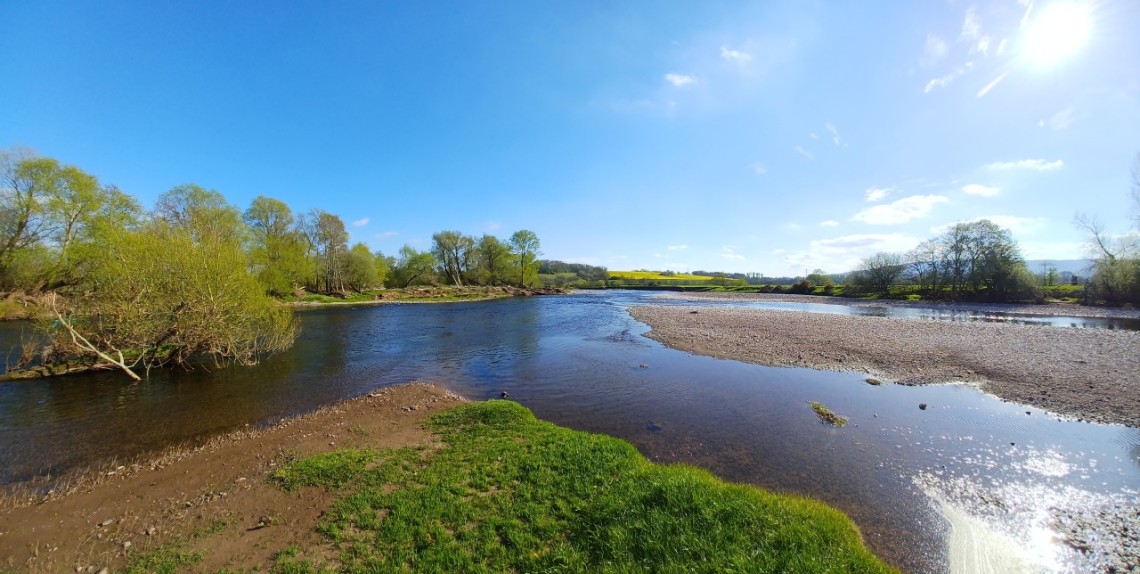 Greenbank - SJ from Herefordshire
Greenbank - SJ from Herefordshire As we turned from March into April the upper Wye water levels had already become quite reduced and the middle of the river was now more likely to produce salmon than the top. There were quite a few reports of lost fish. Bob Mason had a 10 pounder on fly from the Golden Mile on the 2nd. Kenny Powell had a 25 pounds fish from Holme Lacy on the 3rd while DE from Warwick had a 9 pounds salmon on a Flying C from Winforton.
Trout fishers were having more consistent results, despite the cold winds and sometimes glaring bright sunshine. GW from London with a friend had a good day on the Breconshire Fishery on the 2nd, taking 22 trout between them. On the following day NG from Cardigan reported 5 trout between 1 and 2 pounds from the Wye at Ty Newydd – very much an above average size for Wye trout. We also heard from the Llandysul AA water of the Teifi, where VD from Llanelli with a friend accounted for 15 brown trout and 15 sea trout, all of them quite small.
Salmon catches on the middle and lower Wye seemed to accelerate at this point, possibly because of recent spring tides. Glyn Caute had two more of 10 and 15 pounds from Lower Carrots and Luggsmouth; Dean Epton a 9 pounder from Winforton; Kenny Powell a 12 pounder from Holme Lacy; and a 12 pounds silver fish was taken on a Snaelda down at Wyesham.
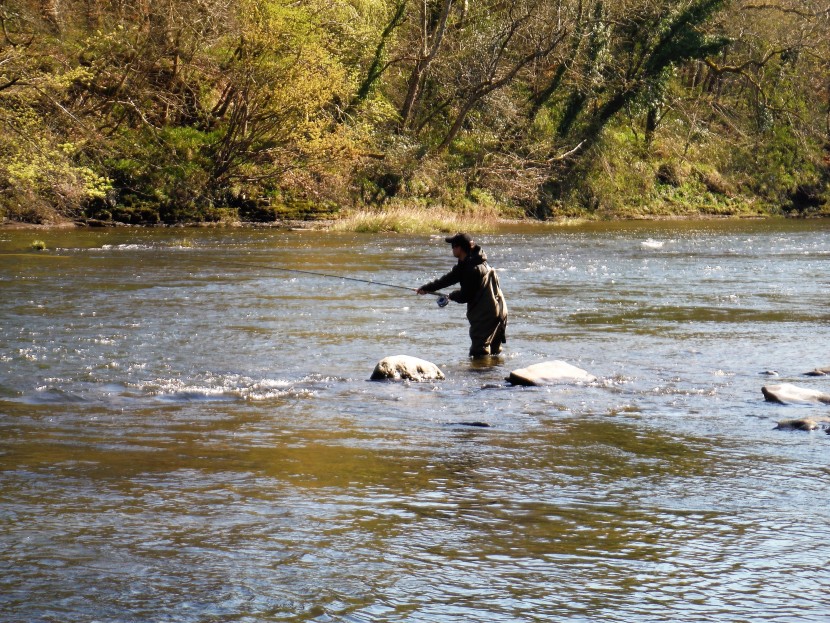 Llangoed spring salmon fishing
Llangoed spring salmon fishing 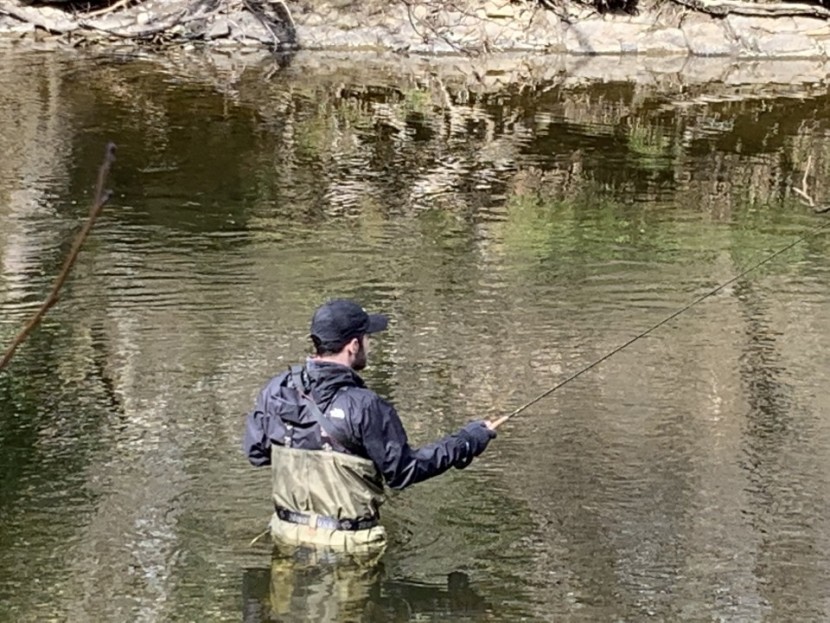 Cefnllysgwynne - AC from Nailsea
Cefnllysgwynne - AC from Nailsea Hopefully there won’t be space to mention every salmon to be taken this spring, but I will take note of a superb silver hen fish of just under 40 inches taken on a Red and Silver Flying C on the Ross AA water on the 5th. This was from Hom Pil, a pool I got to know quite well last spring while locked out of Wales, and the successful angler was Trevor Hyde. Trevor is the chairman of Ross AA’s salmon section and does a lot of work for the club and the river. In the spring he makes a point of showing new members every pool and every known lie on this extensive water – be prepared, it’s a walk of about 10 miles up and down! Not every club will welcome you with such care.
Salmon catches on the lower river particularly continued to pick up. Clive Pegler from Clevedon had a 17 pounds fish on a Flying C from Courtfield on the 6th. Another came from the Ross AA Weir End beat as John Daniels took a 12 pounder, also on a Flying C. Also on the 6th, Wyeham reported two mid-teens salmon taken spinning, while Bigsweir had fish of 20 and 18 pounds, these taken on the fly. Wyesham’s response next day consisted of fish of 21.5 and 11 pounds, this time on the fly and both sea-liced.
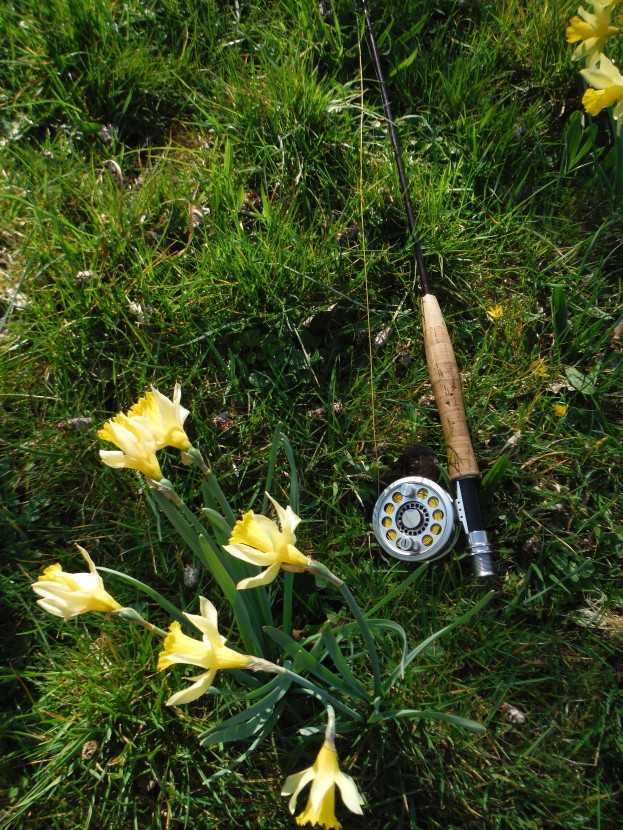 Season's opening
Season's opening 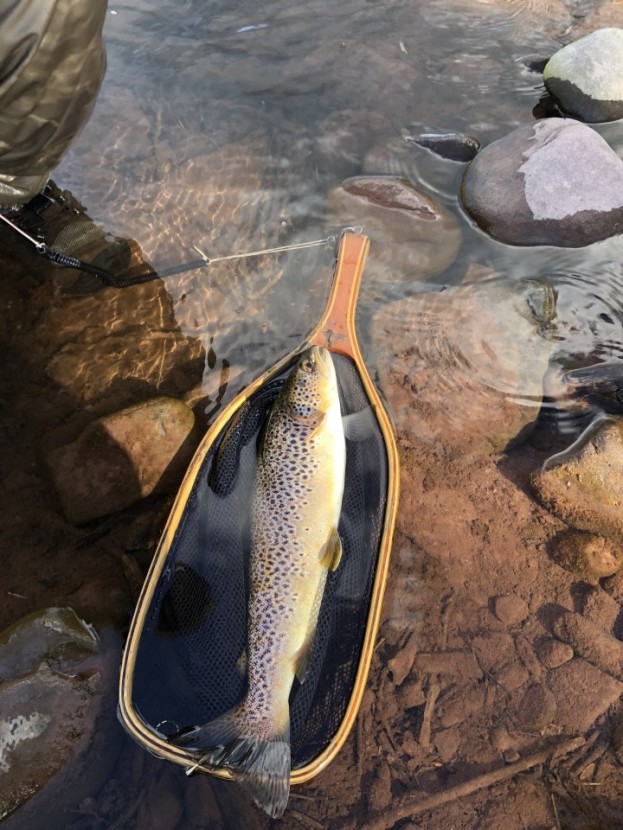 Dinas - SR from Ruislip
Dinas - SR from Ruislip Meanwhile GW from London with a friend came to fish Talybont Reservoir and took 9 trout: “…good buzzer fishing at the top end.” It’s not widely known that Talybont sometimes has quite extensive hatches of relatively large chironomid midges early in the year. RB from Redditch had 5 trout from the Wye’s Rectory while MD from Surbiton had a very impressive catch of 8 from Glan yr Afon on the middle Usk. Of these, no less than three weighed 2 pounds, and of the remaining five, all but one were over the pound. VC from Ashford recorded 5 more from Glan yr Afon on the 8th; DM from Swansea had 8 from Ty Newydd on the 10th; FR from Hereford recorded 7 trout to 16 inches from Abercynrig; and IC from Gloucestershire recorded a single 16 inch trout from Old Clytha on the lower Usk. Going back to the 8th, Wyesham experienced four salmon caught by four different anglers: 10 pounds, 10 pounds, 11 pounds and 14 pounds. That rather indicates a nice fresh pod of fish moving in on the tide. On the 11th they had a “16 pounds bar of silver” on a Willie Gunn. James Tustin from Worcester kicked off the season for Goodrich Court with a 12 pounds fresh salmon taken in the Vanstone Pool.
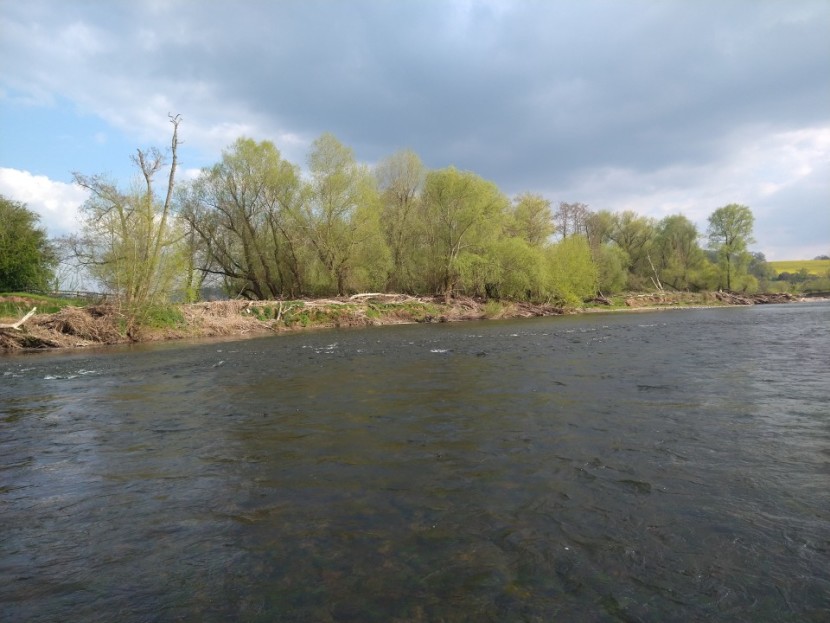 Greenbank - PT from Fairford
Greenbank - PT from Fairford 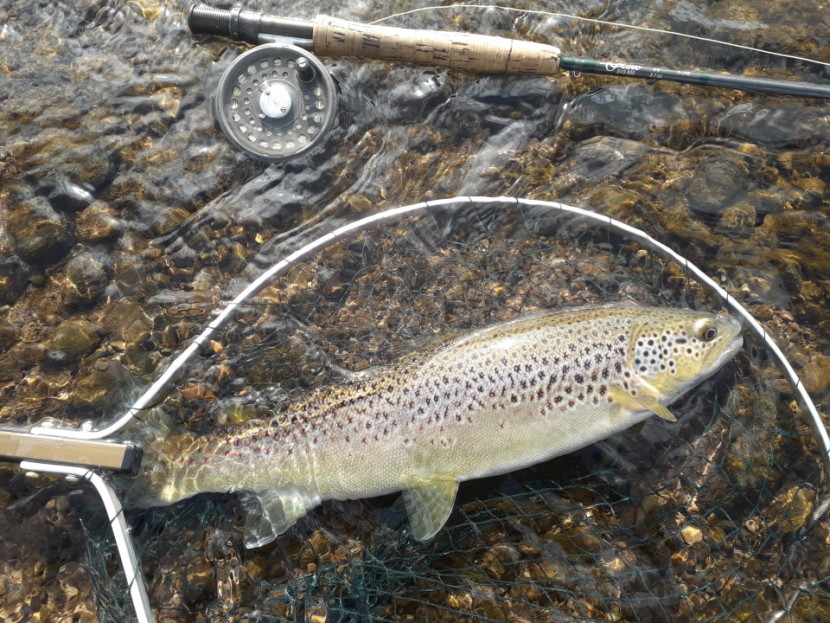 Greenbank trout - AK from Churt-
Greenbank trout - AK from Churt- And AK from Churt in deepest Surrey reported a “great day” on Greenbank. This certainly was a great day with eight trout from 15 inches to 19 inches, which is likely to equate to from 1.5 pounds to 3 pounds! All the trout from the Usk’s Greenbank seem to be big ones! AK wasn’t clear whether the trout were feeding on grannom or olives, but they were certainly taking his artificial. ND from Framilode had half a dozen trout on dries and spiders from Dinas on the 12th. JG from Hook fishing at Ashford House accounted for a 2 pound trout using a Red Spinner, “the dry fly fisherman’s sheet anchor on a strange river.” (Who originally wrote that? Was it Skues?)
MH from Swansea had half a dozen trout on spiders and nymphs from the Wye’s Rectory beat. Wyesham reported another salmon, 15 pounds this time, taken on a Flying C lure. And there was also another fish of 9.5 pounds for Glyn Cawte at Lower Carrots and Luggsmouth, also on a Flying C. Wyesham had two more fish on the 13th weighing 14 and 15 pounds, one of them sea-liced and both on the Flying C. A second 12 pounder was taken from the Vanstone at Goodrich Court on a Cascade tube by Andrew Hepworth-Smith. AW from Salisbury had 9 trout from Ty Newydd.
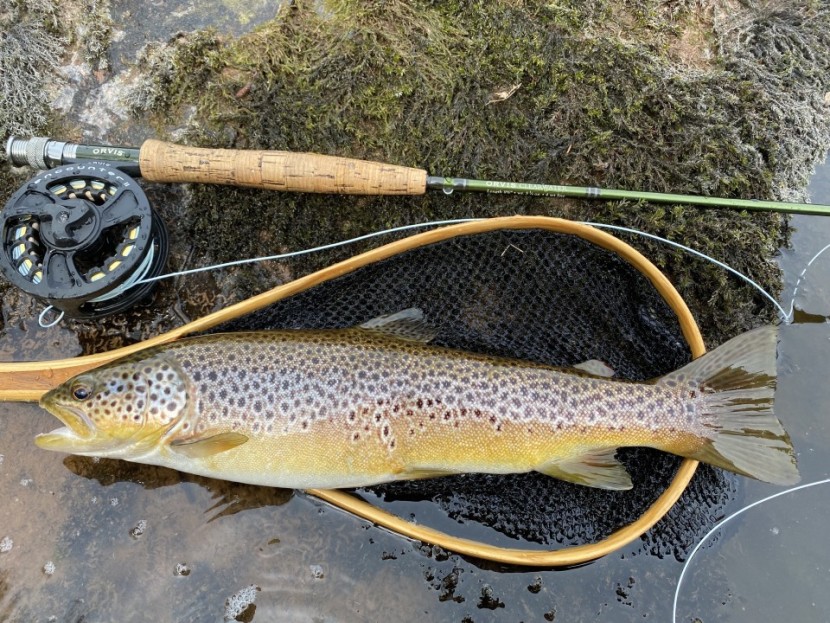 Fenni Fach trout - FR from Herefordshire
Fenni Fach trout - FR from Herefordshire 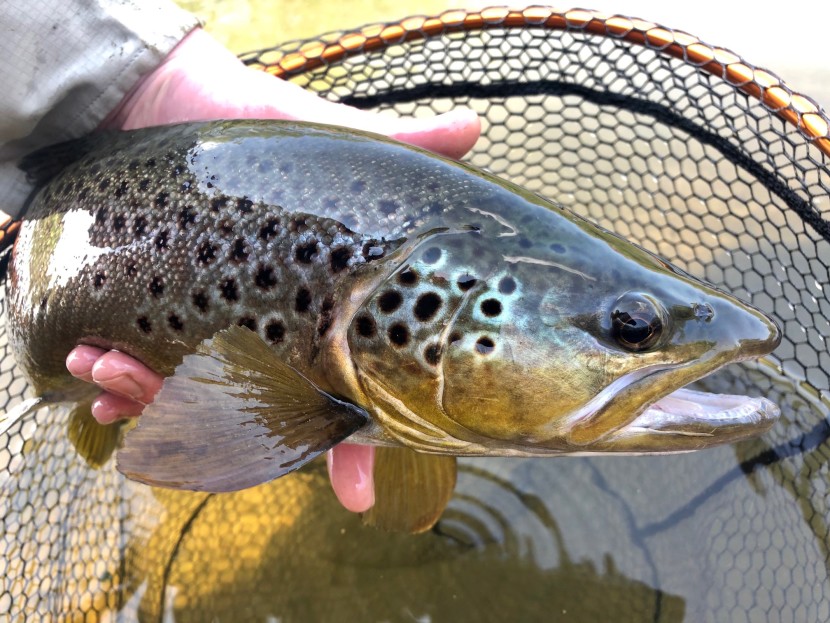 Loughor trout - Lyn Davies
Loughor trout - Lyn Davies By this time salmon were beginning to show more regularly on the lower and middle Wye, and although levels weren’t so high, there was a welcome impression of a continuing run of springers in from the estuary. However the upper river was now so low that there was little likelihood of activity and nothing had yet been reported from the Usk, which was also now quite low.
We now come to the Easter holiday, and as you might expect there was a lot of fishing effort over the long weekend. Slightly surprisingly, the number of canoeists on the Wye seemed much reduced. I came to the conclusion that maybe the nation-wide negative publicity about water quality on the river was having its effect and the idea of splashing around in diluted sewage and chicken unit run-off was not so attractive! High pressure was well in charge by now, significant rain had not fallen for many days and all the rivers were suffering under a hot and bright midday sun by the end of the weekend. There were also some reports of fish mortalities: dead trout seen in the Wye, the Usk and the Monnow, and a large and very unpleasantly dead pike I found in the Wye.
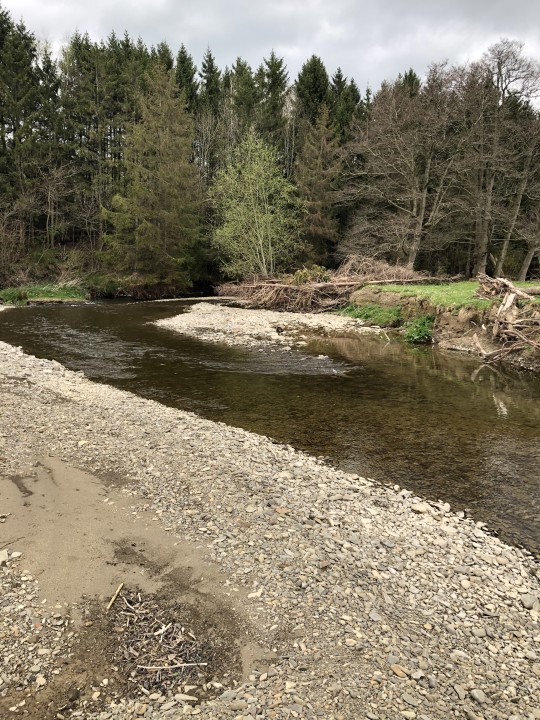 Teme at Bucknell - KD from London
Teme at Bucknell - KD from London Angling quality varied a good deal. The Beacons reservoirs generally fished well and many anglers had good catches. MN from Bristol, one of our regulars, stalked a pair of trout at 17 and 15 inches with the dry fly from the upper Usk at Cwmwysg Ganol, the river being very low and with no hatch. SP from Stoke had 5 from the Breconshire fishery on dry fly. KD from London remarked on the very low water in the Teme at Bucknell and the possibility of some extraction works at the upper part of the beat. I am not sure about the latter, but this beat has a great tendency to run dry through the summer and the EA do keep a close eye on it.
Seth Johnson-Marshall had another good day at Greenbank on the Usk, taking half a dozen trout to 2.25 pounds. This was during a grannom hatch and the trout were reacting. Oddly enough, about the same time while salmon fishing we saw some massive grannom hatches on the lower Wye, the females even crawling on our waders to deposit parcels of green eggs, but in that case there was no reaction at all from fish! See below about the elusive grannom. On the 15th JL from London with a friend had 10 Usk trout to 16.5 inches at Dinas, fishing a nymph New Zealand-style. AW, a member at GLLR on the upper river, had harsh words about careless smoking inside the hut on the Rectory. I suppose that is a matter for the GLLR members!
GM from Broadoak with two friends had 14 trout from Llangoed and Lower Llanstephan. PM from Strettton Grandison had difficult fishing at the rather overgrown Manor Farm on the Usk, but made friends with the farmer’s spaniel which followed him everywhere. PM, that’s a well-known and very friendly dog who sees it as his duty to guide and encourage every visitor. Gratuities are acceptable. BA from Gaydon had 8 trout from Ty Newydd on the Wye. GW from London fished the Tees near the High Force Hotel (Raby Estate) for a dozen trout and had further good days on the 17th and 18th. Large dark olives and March Browns were hatching. FR from Herefordshire had half a dozen trout to 16 inches from Fenni Fach during a trickling March brown hatch, while JL from London with a friend had an excellent brace of 17 and 18 inches in a bag of 7 on the dry fly at Penpont. Up in North Wales, MJ from Bangor had 8 browns and 5 rainbows to 2 pounds from Llyn Ogwen. MH from Swansea had 13 trout on wet flies from the Llanstephan beat on the 19th, while GB from Lancing reported three heavy trout taken on an Olive Comparadun fished in the faster water at Ashford House on the 20th. These were the better results, but many anglers were struggling by now, especially while the sky was clear and the sun bright over shrunken pools.
Salmon fishing was generally all too quiet over the holiday with two fish taken spinning by Steve Negus and Bryan Owen from Luggsmouth and Ingestone respectively. There was often a bit more colour in the water than you might expect for dry weather and at least a suspicion of an algal bloom. However I was able to net a fish from Goodrich Court’s Vanstone Pool for my son Malcolm Burch on the misty morning of Easter Saturday. This was a pretty little hen of 30 inches, bright silver, which he got with a fast sink tip and an Abacus tube, and the third fish of about that size taken there that week. On the 20th Steve Boswell from Coventry had a three sea winter salmon spinning upstream on the Ross Angling water.
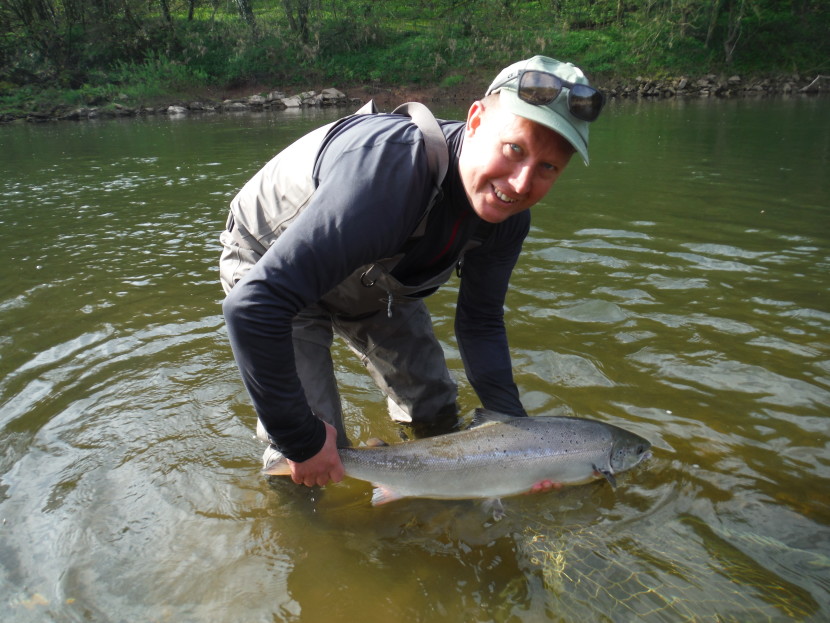 Malcolm Burch and a Vanstone fish
Malcolm Burch and a Vanstone fish 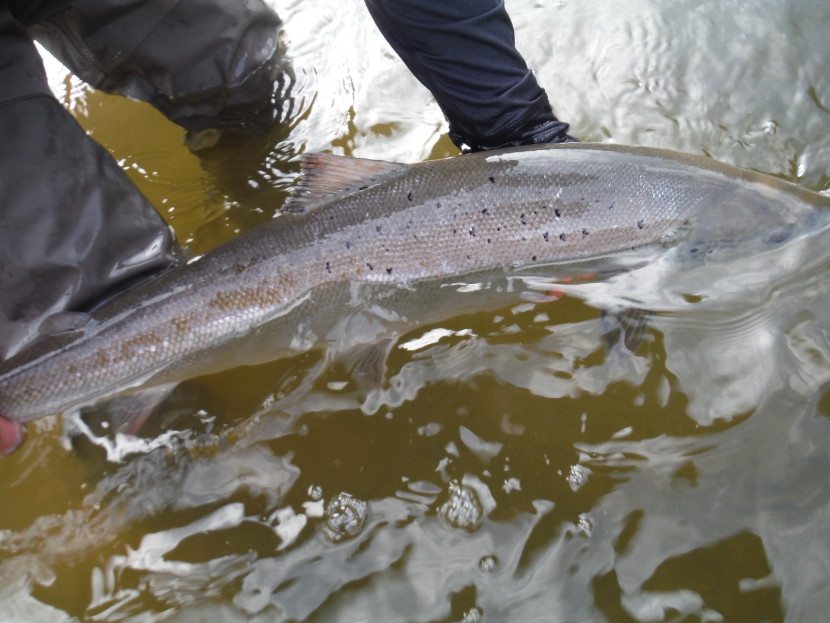 Springer from the Vanstone
Springer from the Vanstone On the 21st GB from Lancing had 5 trout from the Glanusk Ty Mawr / Canal and Rivers Trust beat of the Usk using an Olive Comparadun. KC from Aberdare took 2 trout from Llwyn On and returned 21. I presume these were brown trout returned? He didn’t like the website. PB from Churchdown stalked a heavy trout on Cefn Rhosan Fawr and got it on a dry fly. He also caught a lost lamb and returned it to its enclosure and mother. It urinated on him in thanks. JT from Worcester had yet another fresh 11 pound salmon from Goodrich Court’s Vanstone Pool. This beat has been quite a hot spot this spring. NS of Leicester had a small salmon of 4 pounds from Foy. And back at Goodrich, on the 22nd BT from Nottingham had a fish of 9.5 pounds using a small weighted tube fly.
Also on the 22nd GB from Lancing had 6 trout including 4 heavy ones from the Usk at Abercynrig, but was troubled by anglers on Dinas poaching his water. This is something I was going to write about this month anyway. These two adjacent Usk beats, Dinas and Abercynrig, have received a lot of attention this year. However, if you book one of them, you don’t get the right to fish the other. I have mentioned this before, but the junction between the two beats on the right and only fishable bank is the Abercynrig tributary stream which comes in where there is also a fence line. It’s clearly enough marked on the map and easy to see when you get to it so there is no possibility of making a mistake. You might also consider that you can be seen from a long distance away. If you are booked on Abercynrig, please don’t be tempted to sneak your way above the tributary stream into Dinas. And if you are booked on Dinas, please don’t poach your way down past the boundary into Abercynrig. Please fish the beat you have paid for, not the other one, which another angler has the right to enjoy undisturbed.
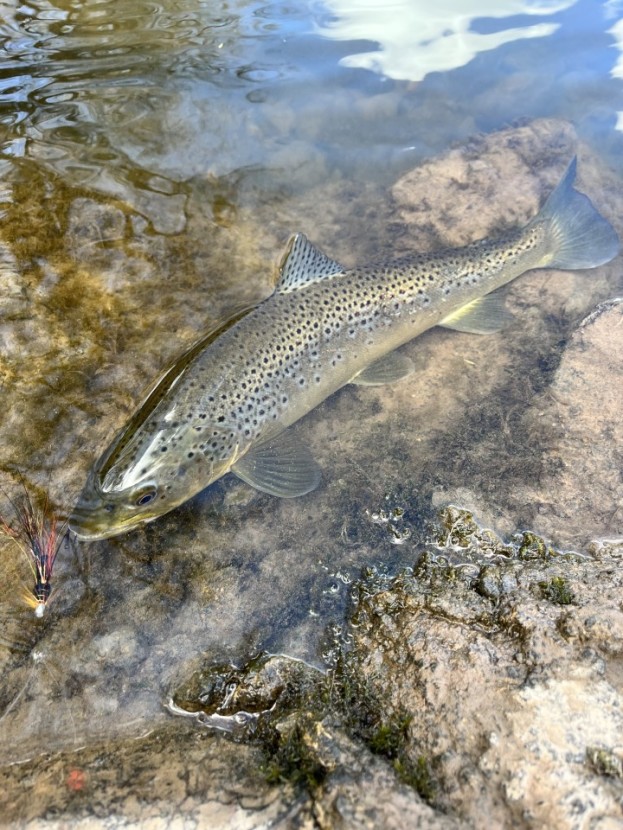 Symonds Yat trout - KM from Oxford
Symonds Yat trout - KM from Oxford 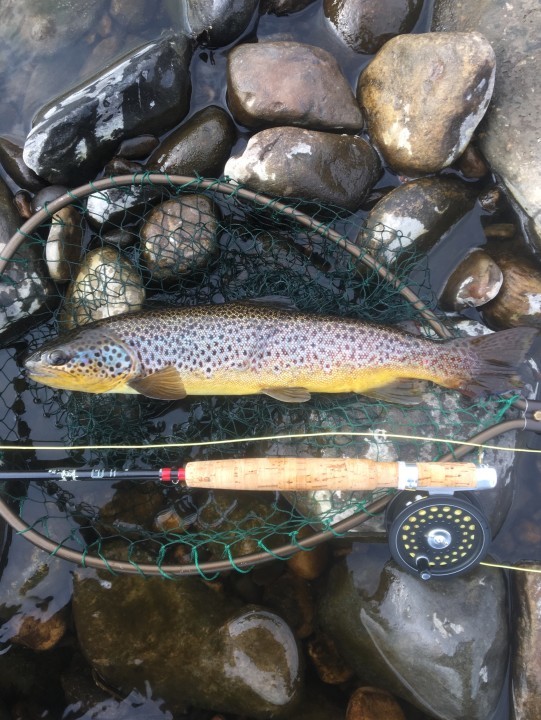 Tees trout - TB from Tunbridge Wells
Tees trout - TB from Tunbridge Wells Importantly and additionally on the subject of Abercynrig, some maintenance is urgently needed now for the stiles, both top and bottom, which give access to the river. The upper stile is quite dangerous. Those who fish Dinas might like to note that currently the left lane of the west-bound Brecon by-pass is currently coned off, due to some works on a landslip about half-way along. This work is likely to go on for some time, but do not be put off; it is not a problem to slip through the cones when you come to the layby and gate leading to the Dinas parking. Just follow the directions given by WUF.
JA from Leominster was out on the Middle Llynfi Dulas beat and got 8 trout on nymphs and dries. I think that is the first report we have had from the Llynfi system this year. On the 24th GLLR member AH from Swansea had 20 small trout from the fast water on the Wye’s Gromaine and Upper Llanstephan beat. MH from Swansea, also a member, fished the same beat next day and recorded 12 trout to 17 inches…but in his case fished down to the Dolmeudwy Pool which is part of Lower Llanstephan and Llangoed. DS from Pegswood Morpeth recorded 6 trout from Llwyn On and asked if there might be a catch and release option – only for brown trout I think. On the 26th JA from Leominster fished again on the Edw at Hundred House and accounted for 11 small brown trout.
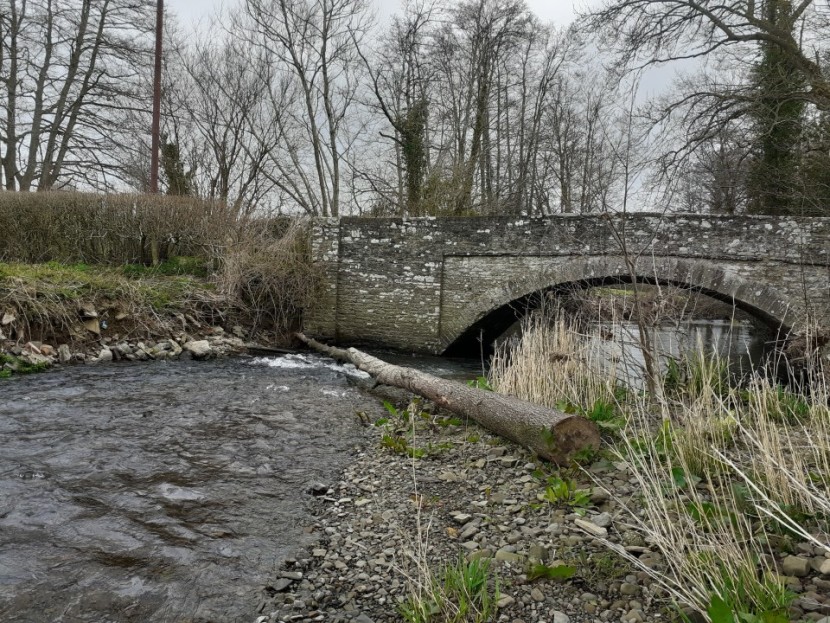 Whittern, Lyonshall - JA from Leominster
Whittern, Lyonshall - JA from Leominster 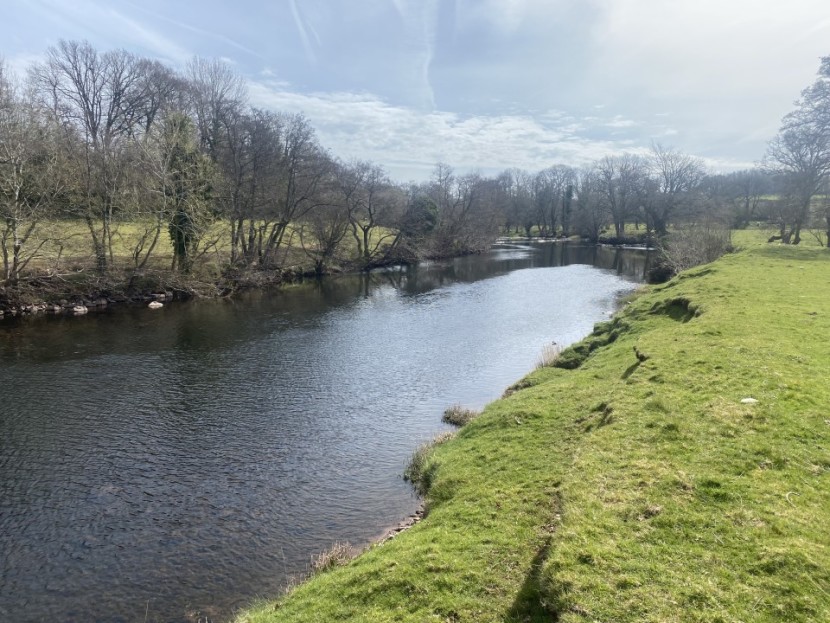 Abercynrig - FR from Herefordshire
Abercynrig - FR from Herefordshire Meanwhile Wye salmon numbers were building up despite the lack of water, mainly from below Monmouth and particularly at Wyesham, but with a few added from the middle river. On the 21st Robin Stuart reported a 24 pounder from the Joe Sirley crib at Redbrook. James Tustin had another 11 pounder from the Vanstone Pool at Goodrich. Next day Wyesham reported a fish of 13 pounds on a Flying C, while Steve Negus had a 14 pounder at Lower Carrots and Luggsmouth. Wyesham reported fresh fish of 15 and 24.5 pounds taken spinning on the 23rd, and three more to 14 pounds on the 24th, this time on fly. Mike Beech had a 15 pounds fish on fly from Holme Lacy 4 on the 26th, while Wyesham reported three more on the fly, weighing respectively 9, 11 and 20 pounds. Gerry Odey had an 11 pounds fish from the Golden Mile on the 27th, Simon McLucas had a 9 pounds on fish from Redbrook while Wyesham added two more sea-liced fish, 12 and 18 pounds. A floating line, sink tip and a tube or decent-sized double was their recommended method at this time. Swan Meadow reported a silver fish of 9 pounds taken on the fly, which is the first I have heard about from the Usk.
Catches of all kinds slowed down in the final week of April due to the very low water levels. Most trout anglers were struggling by now. The river beds everywhere had become covered with slime, making it clear that the flood, when it comes, will be a dirty one as that lot washes out to sea! Several more spring salmon were recorded from Wyesham, but even on the lower river the conditions were far from ideal. At the end of the month we had 74 Wye springers recorded: 13 in March and 74 in April. Due to the low levels on the Towy and particular concern about the effect on seaward migrating smolts, NRW organised a special discharge from Llyn Brianne dam to last 5 days at the end of the month. Towy anglers were warned to be cautious as this would result in a rise of about 20cm as measured at Manorafon.
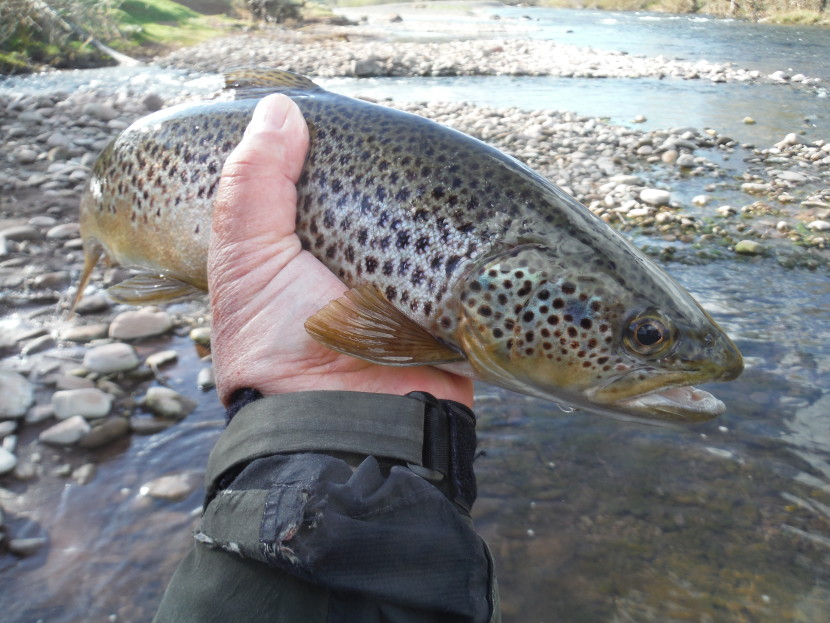 Abercynrig trout
Abercynrig trout 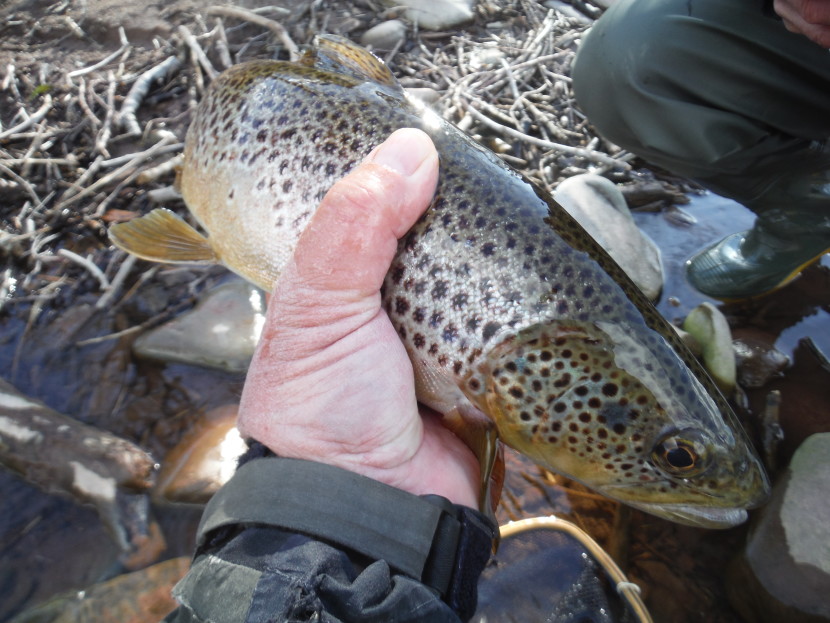 Dinas trout on spiders
Dinas trout on spiders Towards the end of March I saw the first few grannom sedge when the sun was out for a moment. On April 5th there was a massive late afternoon hatch on the upper Wye at the Rectory, but the trout didn’t seem to react as they had for March browns earlier and we were after salmon anyway. The same thing happened at Goodrich Court a couple of days later until our waders were covered with fly – but not a fish rose. The best description of the grannom or greentail fly I ever read was written by Walter Gallichan, who fished and wrote about our Welsh and border rivers a century ago:
“Upon early rivers, this fly makes its first flight in the last week of March, and is often seen when the March Brown is beginning to appear. Its four wings hide its body when the fly is at rest. The wings are a light dun with a hint of yellow and with light brown speckles. The body is dark with light strips on either side of the tail. Occasionally an accumulation of eggs will be observed. The legs are brown and there are black antennae. The artificial Greentail is rarely refused in the right season.
A rise to the Grannom can be quite as thrilling as a rise to the Mayfly. It is not a big fly, but is conspicuous as it flits along the surface of the water. It does not face the kind of weather that enlivens the Iron Blue, that creature of dark and blustering days. The Grannom is a lover of sunlight. The passing of a cloud before the sun will send these creatures into hiding in the bushes. Upon the emergence of the sun the air will swarm again with flights of the Grannom whose zigzag movements are characteristic.
The first hatches of the Greentail seem uninteresting to the trout who have been feeding upon the March Brown or the Blue Dun. In a few days the trout settle down to a feast. A favourite ‘stand’ during a Grannom rise is the tail of a pool or the slow glides. If the wet fly is used, it is profitable to have three on the cast, but to my mind the prettiest sport is with a single floating fly. I esteem the Grannom above the over-rated and elusive March Brown. Time after time I have waited for those wonderful flights of March Brown that one used to see. I suspect that the March Brown is much scarcer than it was in my younger day. The Grannom holds its own against frosts and enemies. I saw millions of them last year.
Walter M Gallichan, 12 May 1917.”
It seems the March brown at least is doing better on our rivers than in Gallichan’s day. A few anglers did report good grannom hatches on the Usk this year, but I have not been so lucky.
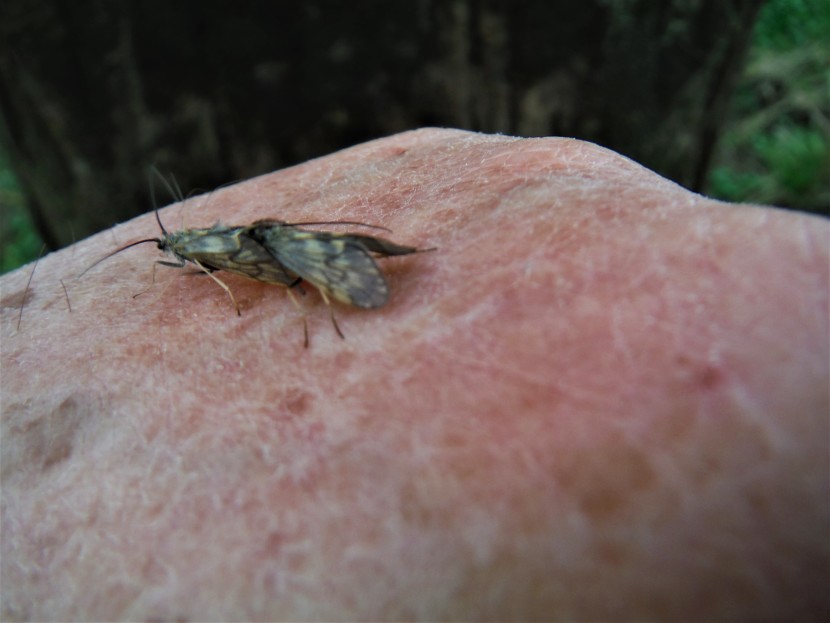 Mating grannomxxx
Mating grannomxxx 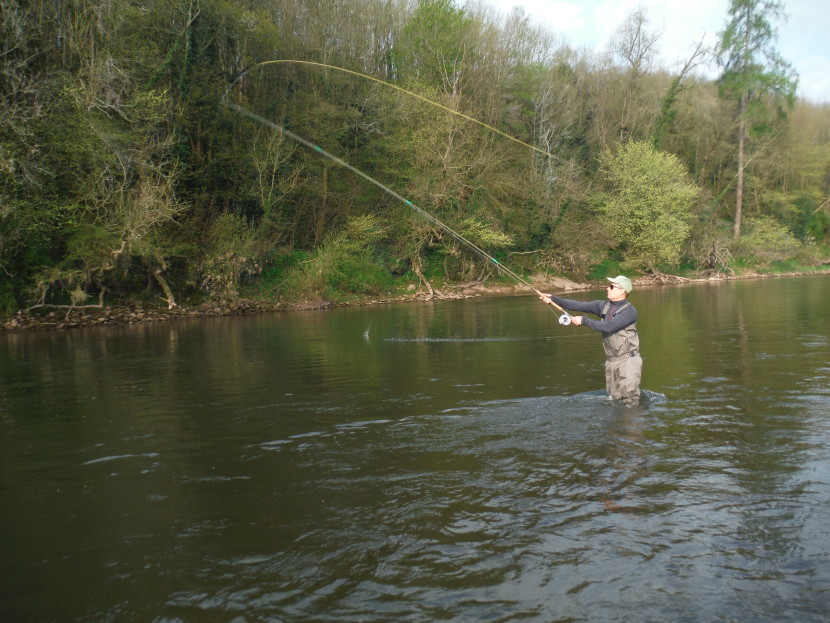 Single Spey cast
Single Spey cast I had an interesting conversation with Lyn Davies of Pontardulais the other day. Lyn, whose family have been fishing for sewin in that corner of SW Wales since Noah built his ark, has been reappraising his fishing interests to reflect a new situation. As everybody knows, the sewin runs have been reducing on his local Loughor, Towy and Teifi in recent years. Nobody is absolutely sure why, but there is no doubt that the numbers of migratory trout are declining in these rivers once famous for their sea trout / sewin. On the other hand the salmon runs, mostly late in the season, are holding up quite well. Less generally known is that some really nice brown trout are starting to be taken, even fish of 2 to 3 pounds, and that the general size of native brown trout is increasing in rivers which used to be full of tiddlers. While Lyn used to begin his serious fishing by night in early June, he starts now in March during the day. His familiar 10 foot 8 weight sewin rod with intermediate line lies idle at home while he concentrates on the usual light-weight brown trout methods, both with dry flies and nymphs. He is seeing the same sorts of spring hatches you might expect on the Usk, particularly large dark olives and March browns. I also have the impression he is having more fun than he used to have mooching around in the dark after a fish which is becoming scarcer season by season!
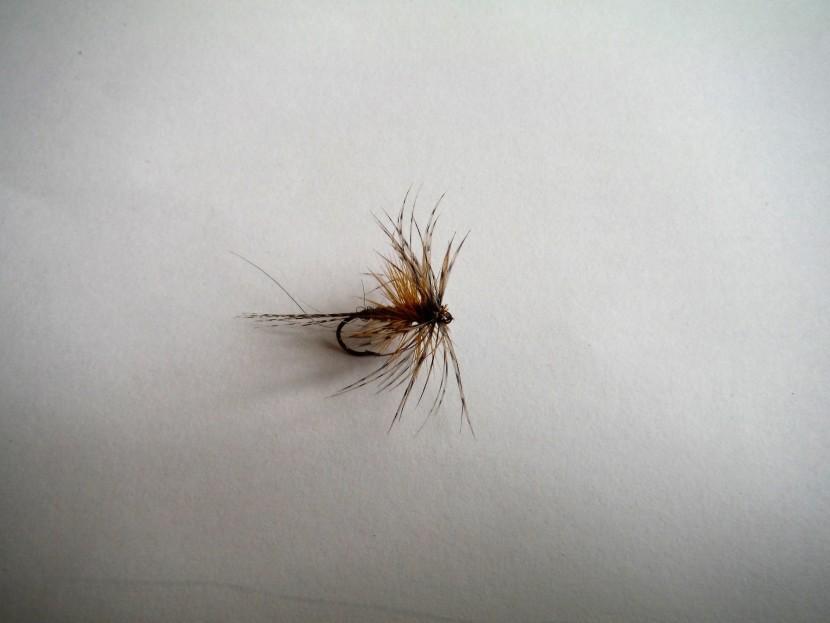 March Brown Jingler
March Brown Jingler 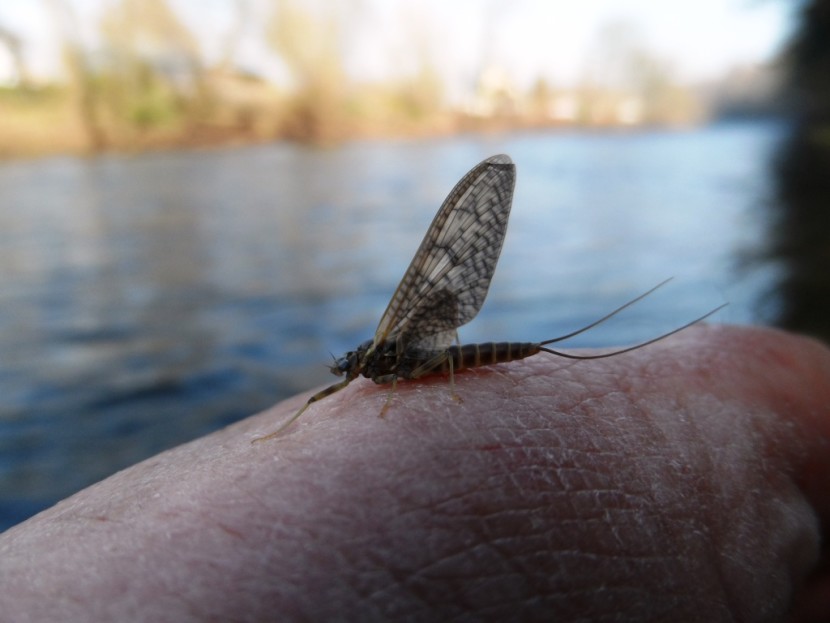 March brown
March brown 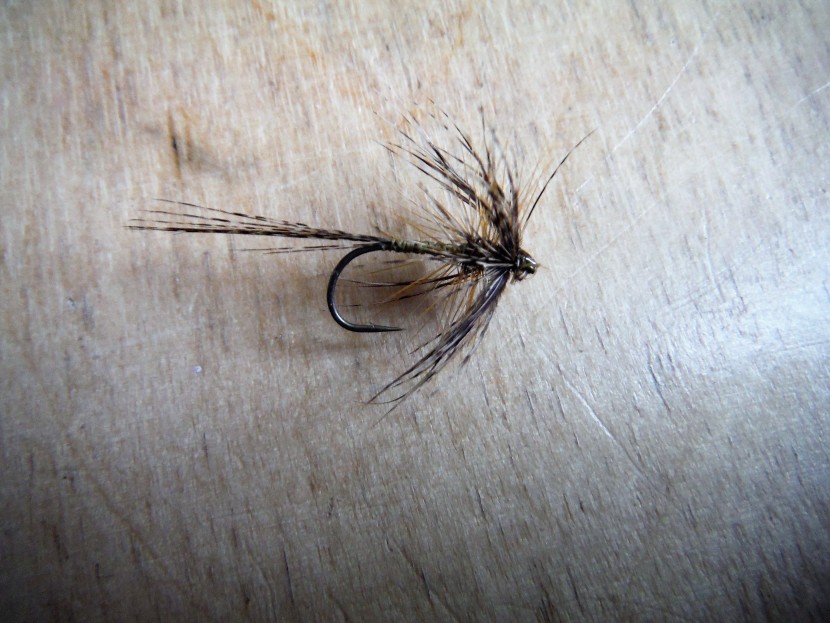 Olive Jingler
Olive Jingler Why the change in the population of these rivers? A better question might be: why are much smaller numbers of the domestic brown trout of these rivers now taking the option of migrating to sea and thus putting on weight and growth there? One very compelling theory has always been that good sea trout rivers tend to have very poor natural feeding, perhaps due to highly acidic water quality, and that thus those trout which do remain in fresh water will be stunted and small. This is often the case, but not an absolute rule; rivers like the Test, for example, can produce good sea trout but excellent wild brown trout also. Scotland’s Spey would be another obvious exception. Nobody can really explain this. There have been some unfortunate and highly publicised pollution incidents on the three Welsh rivers mentioned, but the fact is they most of them currently have quite healthy populations of aquatic insects, so that there is every reason to think that native brown trout would be able to grow on well. Certainly we know that big trout are living in them these days. One reason may simply be that anglers like Lyn are deliberately targeting them now during the day, as opposed to catching the odd one by accident while spinning for sewin and salmon during a flood.
My inclination would be to follow Lyn’s lead and go fishing for what is available, and to thank my lucky stars for it while carefully returning my catch to the river. Sadly, it seems there is another view amongst traditionalists in the area. This is that the Loughor, the Towy and the Teifi are “sewin rivers,” and should be preserved as such with no place in them for large brown trout. These, the boys of the old school argue, should all be killed whenever encountered as they will devour the parr and smolts of migratory fish and thus depress the sewin run even further. I’m afraid I can’t see this reasoning at all. I’m sure heavy trout do eat fry and parr, but so do 10 inch trout and a lot of other creatures. The old school are very definite about what they define as “sewin rivers and “know for a fact” what should be done to defend them, ie the slaughter of all brownies of any size. I’m not so certain I understand exactly what is happening and, like Lyn, would suggest fishing for and preserving these big trout while they are around, while we try to find out more about them. Lyn makes the point that the very fact that more anglers are now fishing during the day has taught us a lot.
You may remember the problems we had last year in fishing our Forest Pool. These were caused by an outbreak of the crayfish plague, beginning in the pool immediately above us in the narrow valley, and then gradually spreading upstream and downstream. This plague is carried by the invasive American signal crayfish, but tends to wipe out the native British white clawed variety. The outbreak was particularly difficult in our case, because while streams in neighbouring valleys have already been invaded by signals, ours is one of the last strongholds in the county of white claws. No American signals have been found yet. Our pool also happens to be a SSSI. We probably won’t ever find out how the disease arrived, but it might have been transported by an angler, a poacher, a water bird, a deer, a feral boar, or a swimming dog. Whatever the cause, fishing had to stop in early summer, and for a while it stopped in all of the Forest streams and lakes. Some were fenced off from public access. While the process of the disease was being monitored, obviously there was a concern to prevent further transmission, either inwards or outwards. Quite a few organisations were involved here: the Syndicate, Forestry England as the landlord, the Environment Agency, Natural England and CEFAS investigating the disease.
After nearly a year, we were finally able to reopen fishing on 1st April. With a small group of 20 members, most of them living locally, it has proved possible to organise suitable protective measures. Nets used will be restricted to use in just the one pond, while protective treatment using Virkon aquatic disinfectant will be applied to boots and tackle before and after fishing. Before stocking with new fish from Exmoor, a certified virus-free source, Nigel our secretary went down to try out the water, as I did the following day. We each caught a caught a couple of rainbows, hard-fighting if slightly thin, which must have been survivors from the spring 2021 stocking. What was interesting in addition was how much to the fore the little native browns were as we fished this time. Our conclusion is that normally the browns are inhibited by the presence of shoals of much larger rainbows. At the time of writing, two of the WUF’s Forest of Dean wild streams (Cannop Brook and Blackpool Brook) remain closed due to continuing concerns about the plague.
When the May editions of the fly-fishing magazines landed with a bump on the door mat, I was intrigued to see some familiar fishing locations mentioned. Trout and Salmon carries an article by Paul Proctor about the Wiltshire Avon at Heale House, where David Burren and I have spent happy hours. I did chuckle a bit at the publicity banner given to it - “untouched trout: jungle chalkstream sport in Wiltshire.” I suppose we could put that down to editor’s licence. In Fly Fishing and Fly Tying Charles Jardine writes – sort of – about the Usk at Brecon, emphasizing how early this river is to warm up and produce rising trout. It certainly lived up to its reputation this spring. Rather more sadly the same magazine reported that NRW has recorded 105,000 sewage spills over a 12 months period. As far as I can see the response from the organisations and committees involved has now moved about as far as agreeing “something must be done.” Meanwhile Natural England and the Environment Agency’s long awaited legal action against a Herefordshire landowner alleging damage to the Lugg at Dayhouse Farm will now go ahead and the case will be heard at Kidderminster in May. That is certainly a step in the right direction. And finally the Angling Trust has been asked to pressure NRW to assess the impact of the All Wales Byelaws for salmon and sea trout with a view to justifying or otherwise their continuance. It is claimed that in 2020 there was a 33% fall in rod effort following the introduction of the byelaws.
Domestic British politics never fails to disappoint. While I’m feeling in a somewhat irritated mood at the moment, it’s no secret that for a long time I have been pretty exasperated with Partygate, which has always seemed utterly trivial and inconsequential to me and to most other people who talk to me about it. I wish the BBC would stop telling me that I’m desperately incensed about the doings at No 10 when clearly I’m not. In fact it’s looking more and more obviously like another assassination attempt against the PM by the usual suspects – the liberal media, Brexit remainers, the Opposition, and now some Tory MPs (including my own) who have rather more selfish personal ambition than capabilities, or indeed willingness to serve either their constituents or their country. The letters to the 1922 committee come out like the daggers in a Shakespearian play, that being the way of the Conservative Party. Et tu Marce! I shall get my own back on my treacherous MP come election time!
I’m not even going to try to either defend or attack the gatherings, legal or otherwise, amongst the workers at No 10. Other people are doing quite enough of that while the rest of us yawn and foreigners look on at British domestic politics in total bewilderment. The police have been unwillingly dragged into it; we have one investigation from a senior civil servant and now there is to be another by a parliamentary committee. How many investigations do we need? And how many more of these “scandals” are in preparation in media editors’offices? We have already been bored to the point of tears by Cummingsgate. Partygate looks like going on for months. Scumgate didn’t really take off, presumably because the perpetrator was of the wrong party, but clearly Legsgate is going to run and run. Porngate, involving a distinctly hapless Conservative MP, looks like being the latest one.
One has grown to expect that, while members of parliament make a great show of describing each as other as “honourable,” in reality they behave like badly brought up children in a very rowdy playground. All the same it’s a bit rich, isn’t it, when an opposing politician with an air of self-righteous smugness describes the PM or indeed any other politician as “a proven liar.” For heaven’s sake, these claiming the higher moral ground are all of them people whose chosen profession was politics, in other words the art of presenting a case attractively enough in order to get elected! I see the Oxford Language US definition also defines politician as “a person who acts in a manipulative and devious way, typically to gain advancement within an organisation.” Pots and kettles are calling each other black in all directions. There is a rather nice fishing story about sanctimonious lectures on the subject of veracity, told by Ernest Philips in an account of early 20th century match fishing in northern waters. A copper kettle was often the prize then for coarse fishermen looking to amass a weight of roach and bream:
“It is said that a few Sheffield anglers went to fish a private match and a kettle was the prize. Finding that fishing was completely “off,” they gathered beneath a tree and started telling tales, and the kettle was placed in the grass in the centre of the group. A parson came along and entered into conversation and inquired what they were doing. To pull his leg they said they were having a match to see who could tell the biggest fishing lie. He administered a mild rebuke, and then added: “Do you know I never knowingly told a lie in my life.” There was a moment’s silence, and then the spokesman of the group nudged his neighbour and said in broad Sheffield: “Gie ‘im t’kettle, Jim.”
To summarize, calling the PM a liar is like calling him a sinner, and we are all of us surely that, excepting a few saints and simpletons. When I exercise my democratic rights towards selecting a leader, I’m not hoping for a person with the morals of the ideal boy scout, but some-one intelligent with courage, a bit of flair and humour, and hopefully judgment. So personally I think Mr Johnson, whose patience in public has so far been outstanding, should ignore the tedious nonsense and press on with addressing some of the real problems facing us, such as the cost of living crisis, Northern Ireland, and - for heavens’s sake - war in Europe!
“Sorry you were out when I visited. I look forward to seeing you in the office very soon. With every good wish,
Rt Hon Jacob Rees-Mogg MP, Minister for Brexit Opportunities and Government Efficiency.”
It’s no secret either that I have a soft spot for Mr Rees-Mogg, although he has been very much criticised, particularly by civil service trade unions, for making this letter public. I think he was absolutely right to do so! Apparently civil service attendance in the office last month was no more than 44%. It seems to me that there should be a message delivered now from those who really have worked hard all through the pandemic, by which I mean care workers, shop workers, lorry drivers, power workers, road engineers and many more who kept us going through the difficult times. And their message to the rest of society will be: “We want our services back!” The excuse that “don’t you know there’s a pandemic on” cannot forever be tendered as a reasoning for sub-standard performance. This particularly applies to GPs and local health clinics who may have to face up to seeing patients again. So please, accept that furlough is over, and let’s do away with the face masks, the taped off waiting room chairs and the rest of it and let us all get back to work. The disease in a reduced form is amongst us, as is the common cold and various flus, and for the most part we can and will live with it.
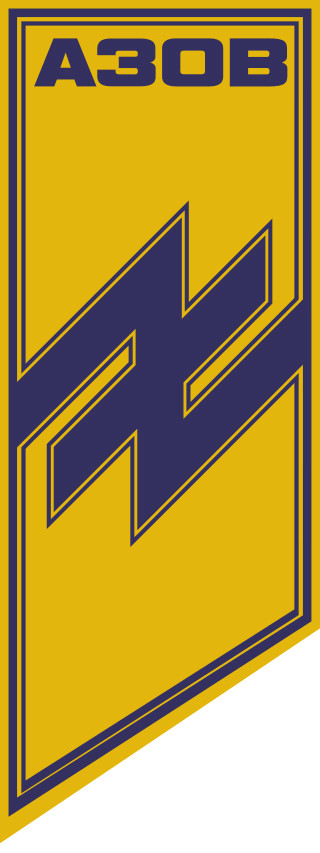 Banner of the Azov Regiment
Banner of the Azov Regiment A couple of days drive to the other side of Europe, people are experiencing a different kind of spring as the Russo-Ukrainian war goes on, the attention switching now from the north and the west to the east and the south of Ukraine. This time we have a European war on a very big scale, but it has taken on the characteristics of earlier conflicts and the grim details of suffering and atrocities are now leaking out as expected. I’m not so impressed with the type of journalism which contents itself with finding some-one who has suffered something truly appalling and then goes on to ask how they feel about it. This is the so-called “anybody here been raped and speak English?” school of interview journalism and I think most of us can already guess how the victim feels about it. There have been more insightful reports, particularly from the BBC’s Jeremy Bowen. Meanwhile let us note that so far we are getting almost no reports from the Russian side of the lines.
I’m reminded also of things which other wars have taught us, one of which is that in military terms it is very difficult to take a city which is resolutely defended by its inhabitants. Men fighting from interconnected cellars can hold out even while heavy artillery turns their city into rubble above their heads. It was true of Stalingrad and it was true of the Bosnian war during which no cities changed hands during a long drawn-out 3.5 years. Mariupol might turn out to be the exception.
At the time of writing, the last hold-outs in the city’s massive steel plant are a special police unit composed of right wing extremists, the Ukrainian Azov Battalion, very likely using weapons we have supplied, and with a civilian human shield. Much might be written about the Azov Battalion which has been fighting in the Donbas since 2014 and whose part Finnish commander has a family history in the Winter War against the Soviet Union. I will just show (opposite) their emblem, the wolfsangel, which may look rather familiar.
The Russians have apparently decided to starve them out rather than lose soldiers in taking their stronghold. Recently there has been much effort made by the International Red Cross to push humanitarian corridors into besieged Ukrainian cities in order to allow civilians to evacuate and to get food and supplies inside. The besiegers might welcome the former purpose, resulting in a kind of ethnic cleansing which may well suit their goals, but they will resist the latter. From Washington the Chairman of the Joint Chiefs of Staff, a calm voice amidst all the dramatic statements and accusations, warned that this war has all the signs of continuing for a long time, meaning years rather than months.
It’s quite amazing how rapidly Ukraine has caused us to review so many previously established norms: energy policy, defence policy, NATO doctrine, financial policy and more. I am afraid the environment is likely to be pushed to the back of the agenda as usual. Meanwhile Ukraine, with one of the worst records for corruption in Europe (just behind Russia), along with a poor record on human rights and freedom of speech, is apparently being offered a fast track into the European Union. Ursula Von der Leyen appeared smiling in front of the cameras in Kiev handing over a sort of embossed application form and promising a wait of months rather than years. Ah well, cynics with a knowledge of Eastern Europe might think, the EU accepted Croatia with similar or worse faults, so it will digest Ukraine without too much trouble. Such EU decisions are no longer the concern of the UK.
A day later our own PM together with the British media arrived for a walk in the same streets with Zelensky. Beyond the grandstanding there is a potential right now for terrible mistakes to be made by world leaders and this is a time to be very careful. Let’s face it, astonishing as it would have seemed a few months ago, we have got ourselves engaged now in a proxy war with Russia, Ukraine being the theatre for the moment. We have been involved in arming and training the Ukrainian military since 2014. And it’s curious whom you might find yourselves in bed with (I’m thinking of the Azov Battalion again) when you decide to fight a proxy war. There has been much talk about what Russian leader Putin really wants and intends, his health and state of mind, what he will settle for and perhaps what might be a way out for him. Many take the view that Putin’s operation and Putin himself are in trouble. The more cynical and fearful of us would suggest that the man has no limits and if Putin goes down, it won’t be without taking others down with him.
Early this spring my wife and I moved at last, just from one side of our little town to the other. This was a down-sizing operation, common to people of our age, all the children now having flown the nest. More precisely, we have moved from the hills close under the Forest on one side of the town, onto the flatlands towards the Severn estuary on the other. Believe me now when I write that we gave quite a bit of thought to the question of flooding when deciding to buy this cottage on a small housing estate. Mediaeval history indicates that much of this land has been won over centuries from the Severn, and at other times taken back by the Severn which flows down from Gloucester to the sea in great loops. However, we are on a very slight levee here, and looming above us is the great spire added during the 19th century to the 12th century church. These houses built 30 years ago are in fact about level with the lychgate and church graveyard across the road. Did you ever see a graveyard flood, I asked myself in an attempt at reassurance?
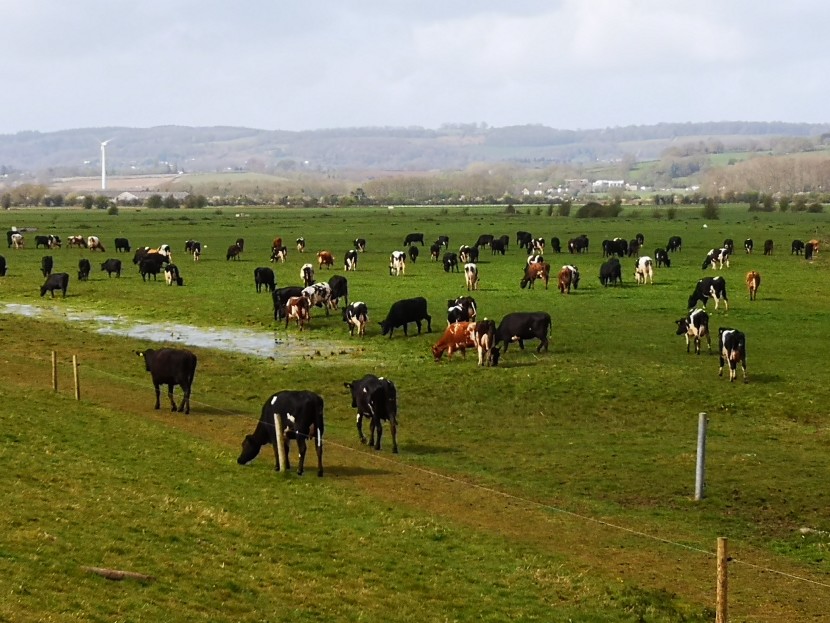 Severnside flats, my town and the Forest behind
Severnside flats, my town and the Forest behind 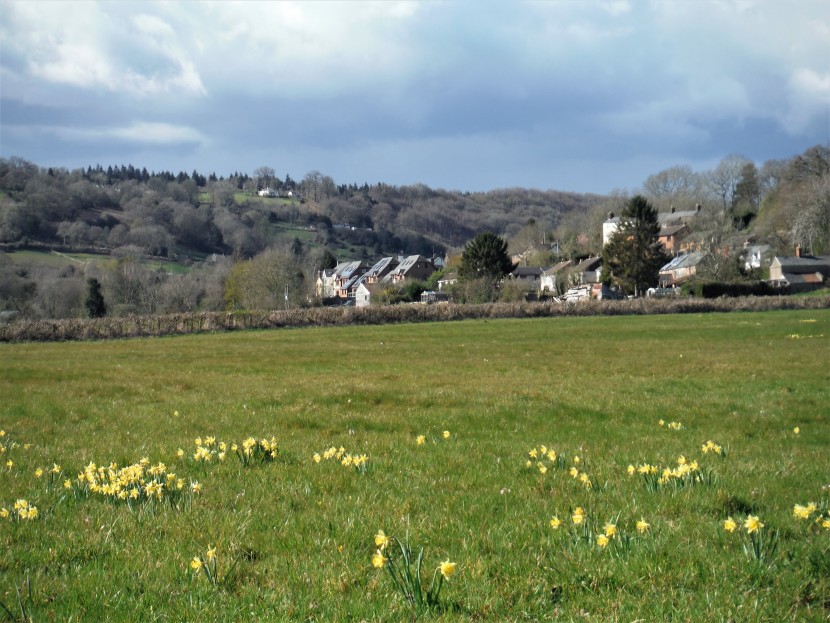 Blakeney village from the Bideford Brook
Blakeney village from the Bideford Brook Nearby is the steam railway spur leading from the main-line junction up into the Forest and it’s a short walk into town across the park. The Cannop Brook emerges from the Forest here, supplies a small feeder and flows through the town, either side of the park, and so in a navigable canal down to join the Severn where with a couple of tide locks it forms our little harbour and port. Centuries ago they used to build coastal schooners and brigs down at the mouth of the Cannop, but now only pleasure boats are moored in the inner harbour. An associated industrial estate is largely derelict, although the Pine End Works by the port used to make wooden components for Mosquito fighter-bombers. On the other side of us is the site of the old grammar school to which my grandfather came as headmaster nearly a century ago, now a modern comprehensive – sorry academy - along with a leisure centre, tennis courts and playing fields. Looking out at night I can see kids practising football under floodlights.
Beyond that are what are called the New Grounds, still part of the Estate founded by the owners of the tin plate works which once defined and expanded the town. I think of this as a post-industrial town, but many still thank the family for the gift after the Great War of the open air swimming pool and handsome town park with its war memorial, playing fields, flower beds, fish pool and band stand. The A48 runs along just below the slopes bordering the flats and the sun shines on the deer park and the gables of the Estate’s manor house on the overlooking hill. There is an excavated Roman temple up there in the deer park with a prospect across the estuary to the Cotswold escarpment. It was once dedicated to Nodens, the ancient British god of hounds and hunting. The clue to the wide plain below, which was all river once, lies in the name. From the house I can sometimes hear the lowing of the vast milking herd which the Estate still keeps on the New Grounds, this being land which does sometimes flood in winter leaving a few islands of ancient woodland, and beyond that there is something like real saltmarsh although defended now by the sea wall. So much for the New Grounds; on some of the older fields alongside the Severn towards Gloucester you can still see the faint marks of medieval strip culture.
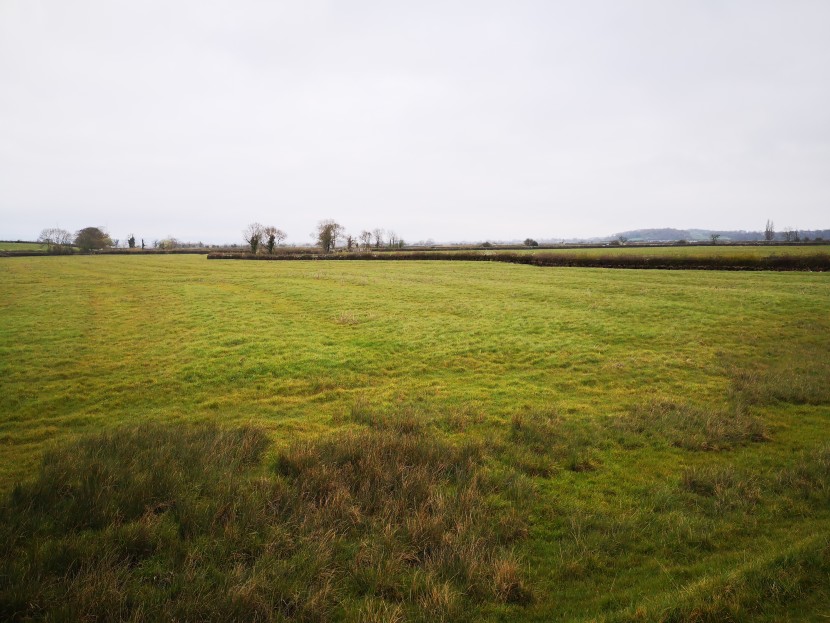 Strip culture still visible by the Severn
Strip culture still visible by the Severn 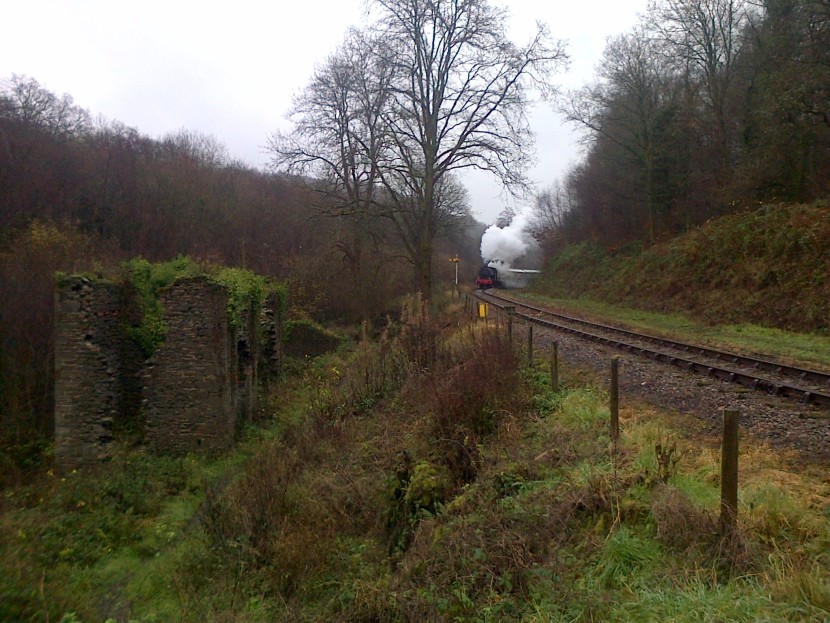 Cannop Valley railway
Cannop Valley railway The birds too are different now, since we moved. Living down here, you are aware that the Severn is closer and mewing sea gulls hover overhead on blustery days to join the rooks tumbling in the wind. And, something which never happened when we lived a mile away on the hill, in half-light at dawn and dusk the skeins of wild geese fly low across us on their way up and down the estuary, honking to each other as they go.
Dawn on the first day of May and gentle rain is falling at last. We are going to need a lot more to fill our shrunken rivers. Tight lines!
Oliver Burch